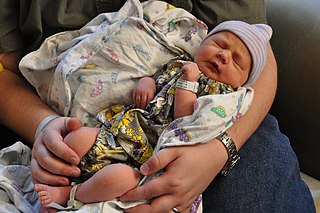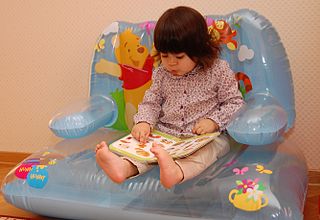Related Research Articles
Language acquisition is the process by which humans acquire the capacity to perceive and comprehend language, as well as to produce and use words and sentences to communicate.

An infant or baby is the very young offspring of human beings. Infant is a formal or specialised synonym for the common term baby. The terms may also be used to refer to juveniles of other organisms. A newborn is, in colloquial use, an infant who is only hours, days, or up to one month old. In medical contexts, a newborn or neonate is an infant in the first 28 days after birth; the term applies to premature, full term, and postmature infants.

In spoken language analysis, an utterance is a continuous piece of speech, by one person, before or after which there is silence on the part of the person. In the case of oral languages, it is generally, but not always, bounded by silence. Utterances do not exist in written language; only their representations do. They can be represented and delineated in written language in many ways.
A toddler is a child approximately 1 to 3 years old, though definitions vary. The toddler years are a time of great cognitive, emotional and social development. The word is derived from "to toddle", which means to walk unsteadily, like a child of this age.

Baby sign language is the use of manual signing allowing infants and toddlers to communicate emotions, desires, and objects prior to spoken language development. With guidance and encouragement signing develops from a natural stage in infant development known as gesture. These gestures are taught in conjunction with speech to hearing children, and are not the same as a sign language. Some common benefits that have been found through the use of baby sign programs include an increased parent-child bond and communication, decreased frustration, and improved self-esteem for both the parent and child. Researchers have found that baby sign neither benefits nor harms the language development of infants. Promotional products and ease of information access have increased the attention that baby sign receives, making it pertinent that caregivers become educated before making the decision to use baby sign.
Baby talk is a type of speech associated with an older person speaking to a child or infant. It is also called caretaker speech, infant-directed speech (IDS), child-directed speech (CDS), child-directed language (CDL), caregiver register, parentese, or motherese.
In cognitive psychology, fast mapping is the term used for the hypothesized mental process whereby a new concept is learned based only on minimal exposure to a given unit of information. Fast mapping is thought by some researchers to be particularly important during language acquisition in young children, and may serve to explain the prodigious rate at which children gain vocabulary. In order to successfully use the fast mapping process, a child must possess the ability to use "referent selection" and "referent retention" of a novel word. There is evidence that this can be done by children as young as two years old, even with the constraints of minimal time and several distractors. Previous research in fast mapping has also shown that children are able to retain a newly learned word for a substantial amount of time after they are subjected to the word for the first time. Further research by Markson and Bloom (1997), showed that children can remember a novel word a week after it was presented to them even with only one exposure to the novel word. While children have also displayed the ability to have equal recall for other types of information, such as novel facts, their ability to extend the information seems to be unique to novel words. This suggests that fast mapping is a specified mechanism for word learning. The process was first formally articulated and the term 'fast mapping' coined Susan Carey and Elsa Bartlett in 1978.
A language delay is a language disorder in which a child fails to develop language abilities at the usual age-appropriate period in their developmental timetable. It is most commonly seen in children ages two to seven years-old and can continue into adulthood. The reported prevalence of language delay ranges from 2.3 to 19 percent.

Vocabulary development is a process by which people acquire words. Babbling shifts towards meaningful speech as infants grow and produce their first words around the age of one year. In early word learning, infants build their vocabulary slowly. By the age of 18 months, infants can typically produce about 50 words and begin to make word combinations.
Language development in humans is a process which starts early in life. Infants start without knowing a language, yet by 10 months, babies can distinguish speech sounds and engage in babbling. Some research has shown that the earliest learning begins in utero when the fetus starts to recognize the sounds and speech patterns of its mother's voice and differentiate them from other sounds after birth.
Child development stages are the theoretical milestones of child development, some of which are asserted in nativist theories. This article discusses the most widely accepted developmental stages in children. There exists a wide variation in terms of what is considered "normal", caused by variations in genetic, cognitive, physical, family, cultural, nutritional, educational, and environmental factors. Many children reach some or most of these milestones at different times from the norm.

Child development involves the biological, psychological and emotional changes that occur in human beings between birth and the conclusion of adolescence.
Co-regulation is a term used in psychology. It is defined most broadly as a "continuous unfolding of individual action that is susceptible to being continuously modified by the continuously changing actions of the partner". An important aspect of this idea is that co-regulation cannot be reduced down to the behaviors or experiences of the individuals involved in the interaction. The interaction is a result of each participant repeatedly regulating the behavior of the other. It is a continuous and dynamic process, rather than the exchange of discrete information.
Phonological development refers to how children learn to organize sounds into meaning or language (phonology) during their stages of growth.
Prelingual deafness refers to deafness that occurs before learning speech or language. Speech and language typically begin to develop very early with infants saying their first words by age one. Therefore, prelingual deafness is considered to occur before the age of one, where a baby is either born deaf or loses hearing before the age of one. This hearing loss may occur for a variety of reasons and impacts cognitive, social, and language development.
Mutual exclusivity is a word learning constraint that involves the tendency to assign one label/name, and in turn avoid assigning a second label, to a single object. Mutual exclusivity is often discussed as one of three main lexical constraints, or word learning biases, that are believed to play major roles in word learning, the other two being the whole-object and taxonomic constraints. This assumption is typically first seen in the early stages of word learning by toddlers, but it is not limited to young childhood. Mutual exclusivity is often discussed by domain-specific accounts of language as limiting children's hypotheses about the possible meanings of words. It is generally accepted that mutual exclusivity alone cannot account for the complexity of word learning but is instead “more like heuristics in problem-solving."
Statistical language acquisition, a branch of developmental psycholinguistics, studies the process by which humans develop the ability to perceive, produce, comprehend, and communicate with natural language in all of its aspects through the use of general learning mechanisms operating on statistical patterns in the linguistic input. Statistical learning acquisition claims that infants' language-learning is based on pattern perception rather than an innate biological grammar. Several statistical elements such as frequency of words, frequent frames, phonotactic patterns and other regularities provide information on language structure and meaning for facilitation of language acquisition.
Memory is one of the brain's most critical functions. It has the infinite ability to store information about events and experiences that occur constantly. Experiences shape the way memories form, so major stressors on socioeconomic status can impact memory development. Socioeconomic status (SES) is a measurement of social standing based on income, education, and other factors. Socioeconomic status can differ cross-culturally, but is also commonly seen within cultures themselves. It influences all spectrums of a child's life, including cognitive development, which is in a crucial and malleable state during early stages of childhood. In Canada, most children grow up in agreeable circumstances, however an unfortunate 8.1% are raised in households that fall into the category of low socioeconomic status. These children are at risk for many disadvantages in life, including deficits in memory processing, as well as problems in language development.
The term 30-million-word gap was originally coined by Betty Hart and Todd R. Risley in their book Meaningful Differences in the Everyday Experience of Young American Children, and subsequently reprinted in the article "The Early Catastrophe: The 30 Million Word Gap by Age 3". In their study of 42 Midwestern families, Hart and Risley physically recorded an hour's worth of language in each home once a month over 2½ years. Families were classified by socioeconomic status (SES) into "high" (professional), "middle/low" and "welfare" SES. They found that the average child in a professional family hears 2,153 words per waking hour, the average child in a working-class family hears 1,251 words per hour, and an average child in a welfare family only 616 words per hour. Extrapolating, they stated that, "in four years, an average child in a professional family would accumulate experience with almost 45 million words, an average child in a working-class family 26 million words, and an average child in a welfare family 13 million words."
Social emotional development represents a specific domain of child development. It is a gradual, integrative process through which children acquire the capacity to understand, experience, express, and manage emotions and to develop meaningful relationships with others. As such, social emotional development encompasses a large range of skills and constructs, including, but not limited to: self-awareness, joint attention, play, theory of mind, self-esteem, emotion regulation, friendships, and identity development.
References
- ↑ Honors and awards for Humbio faculty 2009–2010 Archived July 8, 2010, at the Wayback Machine , Stanford University, retrieved 2010-12-06.
- ↑ Ashford, José B.; LeCroy, Craig Winston; Lortie, Kathy L. (2009), Human Behavior in the Social Environment: A Multidimensional Perspective (4th ed.), Cengage Learning, p. 253, ISBN 978-0-495-60169-2 .
- ↑ Anne Fernald's faculty bio.
- ↑ Daley, Yvonne (March–April 1999), "Wanted: Female Faculty", Stanford Magazine, archived from the original on 2010-06-09, retrieved 2010-12-07.
- ↑ "VersaMe". November 2015. Retrieved July 30, 2016.
- ↑ Bizarre talk makes good tool, United Press International, October 1982.
- ↑ Maugh, Thomas H. II (February 17, 1992), "'Parentese': Universal Language", Los Angeles Times .
- ↑ Nash, J. Madeleine (February 3, 1997), "Fertile Minds", Time , archived from the original on September 13, 2001.
- ↑ Infants influenced by TV: study, CBC News, January 21, 2003.
- ↑ "Research shows TV influences infants' behaviour", Daily Times , Pakistan, January 27, 2003.
- ↑ Fernald, Anne; Marchman, Virginia A.; Weisleder, Adriana (2013). "SES differences in language processing skill and vocabulary are evident at 18 months". Developmental Science. 16 (2): 234–248. doi:10.1111/desc.12019. PMC 3582035 . PMID 23432833.
- ↑ Weisleder, Adriana; Fernald, Anne (2013). "Talking to Children Matters". Psychological Science. 24 (11): 2143–2152. doi:10.1177/0956797613488145. PMC 5510534 . PMID 24022649.
- ↑ Fernald, Anne (1989). "Intonation and Communicative Intent in Mothers' Speech to Infants: Is the Melody the Message?". Child Development. 60 (6): 1497–510. doi:10.2307/1130938. JSTOR 1130938. PMID 2612255.
- ↑ Mumme, Donna L.; Fernald, Anne (2003). "The Infant as Onlooker: Learning from Emotional Reactions Observed in a Television Scenario". Child Development. 74 (1): 221–237. doi:10.1111/1467-8624.00532. PMID 12625447.